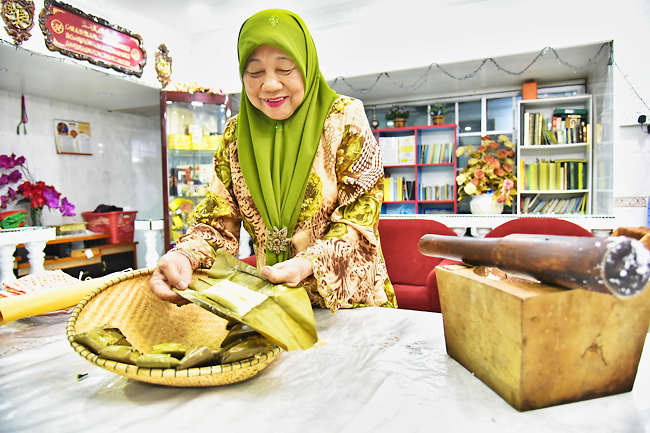Daniel Lim
Many local delicacies are synonymous with the Sultanate’s heritage and culture, which can be found in places across the nation – from high-end restaurants to local food hawkers.
These cuisines can range from more traditional culinary items and dishes such as ambuyat and assortments of kueh like kueh lenggang or kueh pancut.
Among these traditional food items loved across the nation by both locals and foreigners is the kelupis, which is a delicacy that has history associated with it.
Brunei Tourism describes kelupis as rice cakes made from glutinous rice. Wrapped in Nyirik leaf, it is one of Brunei’s all-time favourite snacks. Traditionally, in the Bisaya culture, they’re served as light refreshments during a wedding or special occasion.
There are many varieties of kelupis. Some are served with dried shrimp, and some with anchovies. But on its own, it’s still a sweet delicacy, especially when eaten with peanut or curry dip.

Kelupis – alongside other traditional local delicacies such as ambuyat, wajid, kueh lenggang, kueh pancut and kueh kusoi – has played a vital role in the country’s culinary past and as a food source for communities, and it has since become a part of the national heritage.
Being a delicacy well-known across the country, the common kelupis also has subtle variants found within each district. In the Belait District, the humble kelupis is referred to as kelupis dadak.
Speaking to the Bulletin, Belait resident Hajah Zaleha binti Haji Mokti discussed in-depth how the well-beloved delicacy came to be, how it was adopted and passed down over generations, and how it is different compared to what people associate with kelupis.
“In the Belait District, we call it kelupis dadak (pronounced ke-luu-peh de-dyek). It is derived from rice which is then pounded using alu and lesong (a traditional mortar and pestle) together with coconut.”
She explained that the delicate process involved the use of gegawi (spatula), mortar and pestle.
“We use these utensils to ensure the kelupis dadak is properly packed into the leaves. We then bundle them in tens with the help of a piece of string to ensure they do not unfasten when placed in boiling water.”
In the past, there was no access to modern-day condiments such as curry, which can be found easily in restaurants today. People would pair kelupis dadak with salted fish or pusu kering (dried anchovies).
“Together with grounded coconut shavings mixed with sugar – this is how people in Belait enjoyed kelupis dadak in the past.”
With the unique history relating to how people lived their day-to-day lives, Hajah Zaleha noted that kelupis dadak is considered “the pride and joy of the Belait people,” as this along with various other traditional cuisine makes its mark in various ceremonies.
“Especially during weddings, everyone would be busy making kelupis dadak and other traditional dishes such as wajid. We would make them as a group, which also provides a platform for us to spend time with friends and family in making the dishes and enjoying the result.”
She added that enjoying them fresh out of the pot is also a memorable experience, especially with everyone involved. “As you finish cooking them, it is still soft so it’s quite a treat for all.”
While in the past, Hajah Zaleha used to be able to easily whip up kelupis dadak, she said that she had been slowly dialling back her pace to match her age. She is however willing to share the knowledge and skills acquired over the years with others, especially the younger generation.
As the world continues to march forward in the modern day, kelupis has continued to evolve alongside it, with many comprising hearty filings and an assortment of condiments that serves to further boost the flavour profile, while also accommodating the changing taste buds of the people of today.
This is evident as even today, kelupis can still be found being made and sold from the smallest food hawkers at the local markets to restaurants across the nation.
“The concept of what we consider as kelupis is always changing, but it is important to always understand where our traditional dishes came from and to enjoy both the past and the present,” she said.





